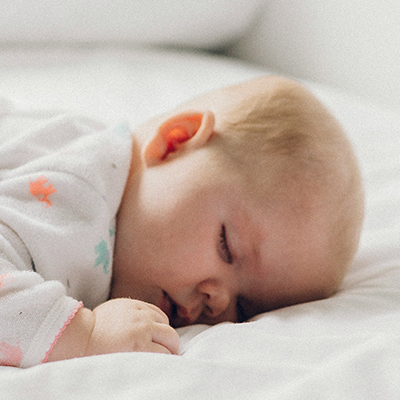Sleep-Disordered Breathing (SDB)
What Is Sleep-Disordered Breathing (SDB)?
Sleep-disordered breathing refers to a group of conditions where a child’s breathing becomes noisy, interrupted, or inefficient during sleep. This can happen due to partial or complete blockage of the airways, often during the night.
Common Types of Sleep-disordered breathing

- Primary snoring: Noisy breathing without oxygen desaturation or frequent awakenings.
- Upper airway resistance syndrome (UARS): Increased effort to breathe during sleep, without clear apnoeas.
- Obstructive Sleep Apnoea (OSA): Repeated episodes of blocked airflow causing breathing pauses (apnoeas) or shallow breathing (hypopnoeas).
- Central Sleep Apnoea (CSA): Rare in children, caused by the brain failing to send the right signals to breathe.
- Mixed apnoea: A combination of obstructive and central events.
How Common Is It?
- Around 10% of children snore regularly.
- Between 2-4% of children have Obstructive Sleep Apnoea
- Sleep-disordered breathing is most common between the ages of 3 and 6 years, often related to enlarged tonsils and adenoids.
What Causes Sleep-disordered breathing in Children?
The most common cause of SDB is enlarged tonsils and adenoids, especially in young children. Other causes or risk factors include:
- Obesity or being overweight
- Allergic rhinitis or nasal congestion
- Craniofacial abnormalities (e.g., small jaw, cleft palate)
- Neuromuscular disorders (e.g., cerebral palsy, muscular dystrophy)
- Genetic conditions such as Down syndrome or achondroplasia
- Premature birth
- Family history of OSA
Signs and Symptoms of Sleep-disordered breathing
During Sleep:
- Loud or persistent snoring
- Pauses in breathing (apnoeas)
- Gasping, choking, or snorting
- Restless sleep, frequent waking, or unusual sleeping positions
- Sweating at night
- Mouth breathing during sleep
- Enuresis (bedwetting)
During the Day:
- Daytime sleepiness or fatigue
- Hyperactivity or poor attention
- Behavioural difficulties, irritability
- Poor school performance
- Delayed growth or failure to thrive in younger children
How Is Sleep-disordered breathing Diagnosed?
Diagnosis starts with a careful history and clinical examination by your GP or paediatrician. You may be asked to complete a sleep questionnaire to assess risk.
Additional Tests May Include:
- Overnight oximetry: Measures oxygen levels while your child sleeps.
- Respiratory polygraphy study
- Sleep study (Polysomnography): A detailed test in a sleep lab to monitor breathing, brain activity, oxygen levels, and more.
- ENT examination: To assess tonsil and adenoid size.
- Imaging or endoscopy: Rarely required, but may be used in complex cases.
How Is Sleep-disordered breathing Treated?
1. Adenotonsillectomy
Surgical removal of the tonsils and adenoids is the first-line treatment for most children with moderate or severe OSA caused by upper airway obstruction.
2. Nasal Steroids or Allergy Treatment
For children with mild OSA or significant nasal symptoms, nasal steroid sprays or antihistamines may help reduce airway inflammation.
3. Weight Management
For children with obesity-related OSA, healthy eating, activity, and weight loss support is essential. Surgery may still be helpful.
4. Positive Airway Pressure (CPAP)
Children who do not improve after surgery, or who are not suitable surgical candidates, may benefit from CPAP therapy—a machine that helps keep the airway open during sleep.
5. Other Treatments
Children with craniofacial or neuromuscular conditions may require specialist assessment and more advanced interventions, such as dental appliances, surgery, or multidisciplinary care.
What Follow-Up Is Needed?
- Children undergoing surgery should be reviewed 6–8 weeks after adenotonsillectomy.
- If symptoms persist or recur, further evaluation with sleep studies may be necessary.
- Long-term follow-up is needed in children with complex medical conditions or obesity.
Summary for Parents
- Not all snoring is OSA—but regular snoring with daytime symptoms should be investigated.
- Early identification and treatment can significantly improve behaviour, learning, and health outcomes.
- If you’re concerned about your child’s breathing at night, consult your GP
Need Advice or a Referral?
If your child is showing signs of sleep-disordered breathing, our paediatric respiratory team can help. We provide comprehensive assessment and treatment for all forms of SDB in children,
Located in London | Infants to young adults seen
Request a referral or book an appointment with Professor Gupta today.